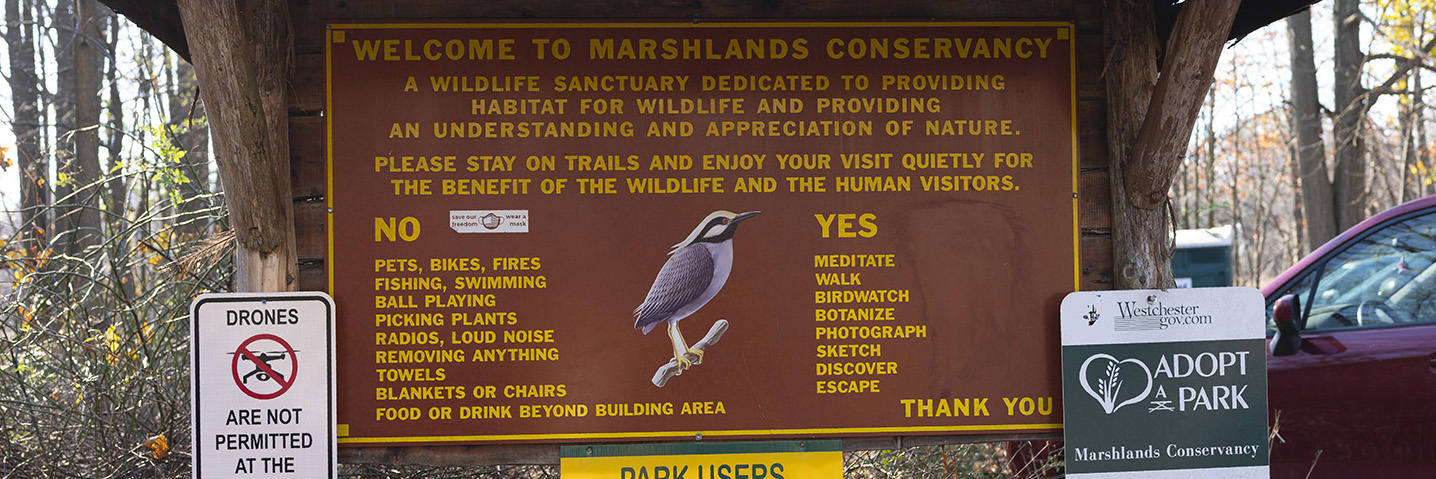Visit Marshlands Conservancy any day of the year! Our trails are always open during daylight hours. It is the perfect place to enjoy nature in a variety of very different settings. Marshlands has five unique ecological habitats: forest, meadow, salt marsh, seashore, and pond. Hike along the three miles of trails. Take your binoculars and camera to see nature up close, record the local flora and fauna and experience the colors of the ever-changing seasons. Wear suitable clothing for the outdoor terrain and the weather.
ACTIVITIES PERMITTED ACTIVITIES NOT PERMITTED TIMES & DIRECTIONS VISITOR CENTER TRAILS & MAP
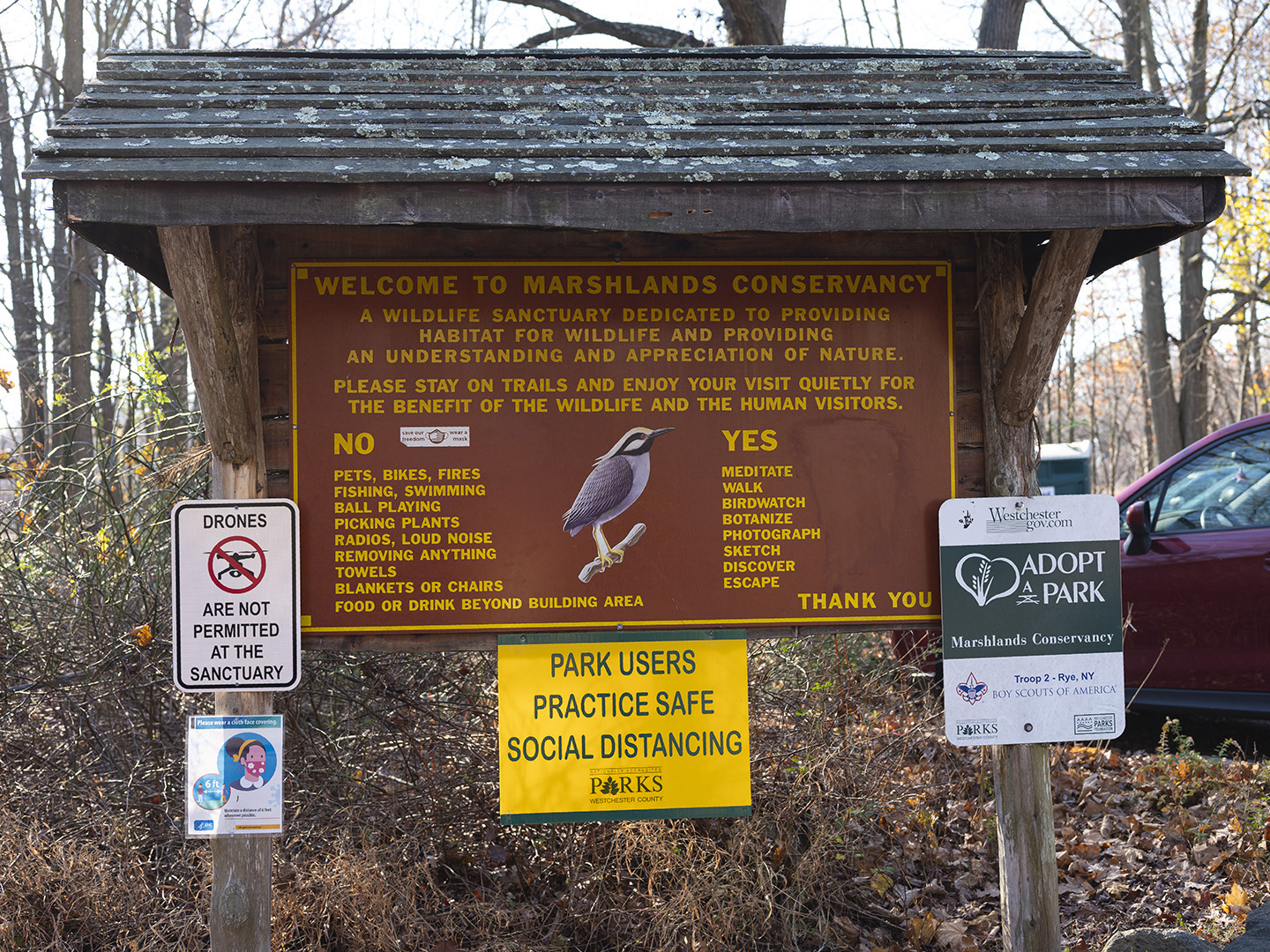
Photo: ©Rory Mulligan
The sign of the yellow-crowned night heron (Nyctanassa violacea) welcomes visitors
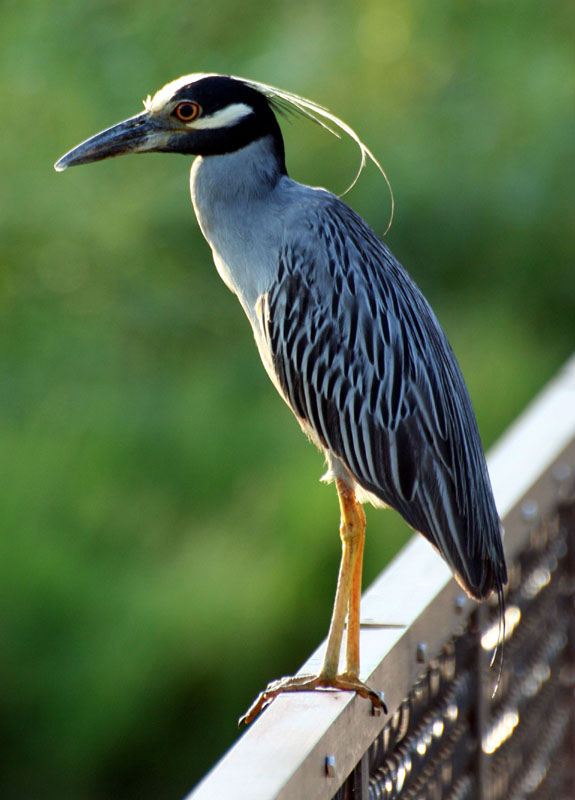 Photo: Michael C. Bochnik
Photo: Michael C. BochnikYellow-crowned night heron (Nyctanassa violacea)
Because the Marshlands Conservancy is a critical habitat and biodiversity reserve, for the preservation of species it is especially important to follow park rules
Species to be Preserved Have Been Designated by the Conservation Division of the Westchester County Parks:
The Conservation Division systematically catalogs the species found in the parks, checks historical records, and networks with other agencies to develop a biodiversity inventory. A list of rare and significant species has been developed in an effort to conserve the ecosystems on which these species depend. In addition, certain tracts of county parkland have been identified as critical habitats or biodiversity reserves for these species.
THE FOLLOWING ACTIVITES ARE NOT PERMITTED IN THE CONSERVANCY
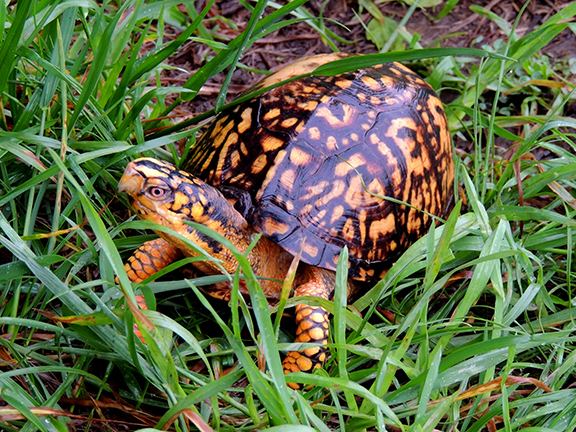
Photo: ©Christina Baal
Living in Marshlands Conservancy, the eastern box turtle (Terrapene carolina carolina) is native to the eastern part of the United States. They are slow crawlers, extremely long lived, slow to mature, and have relatively few offspring per year. Frequently hit by cars and agricultural machinery, they are particularly susceptible to anthropogenic (human-induced) mortality
For your quiet and peaceful enjoyment of the land and the safety of the creatures and plants that live and grow here, please assist us by being respectful of park habitat, wildlife, and other visitors by following these simple rules:
- Dogs are not allowed on Marshlands Conservancy property. Why is that you ask? Your dog, like its wild ancestors the wolf or coyote, is a canine, and it leaves the scent of a predator as it walks around. The sight or smell of your dog can disturb wildlife and alter their nesting and rearing habits. In the past, people’s dogs have destroyed or eaten the eggs of ground-nesting birds and frightened other visitors to Marshlands.
- Bicycles are not permitted on trails. Bicycles accelerate erosion and can damage tree roots. It is also disturbing to hikers and walkers on the trails trying to enjoy the essential qualities of peace and quietude of this natural park.
- Feeding wildlife is not permitted. Animals lose their fear of humans when they are fed handouts of natural or human-made food. Feeding contributes to aggressive encounters and accidents, loss of foraging skills, as well as nutrient deficiency in wildlife.
- Fishing, Hunting, Camping, and Swimming are strictly prohibited.
- Removal of plant, animal, or mineral material is prohibited. Removing these natural resources interferes with many intricate and delicate natural processes and seasonal cycles in nature.
- Keep to the designated trails to avoid damage to sensitive habitats and personal injury. A trail map is available at the nature center.
- No entry is permitted into the salt marsh, the channels, or any beach landing by watercraft. This includes kayaks, boats and paddle boards.
- No Idling. Turn off your engine while you are sitting in your vehicle in the parking lot.
- No parking or stopping on the road. Parking is permitted only in the asphalt parking area.
- Help us keep this park a place of sanctuary. If you see anything suspicious or if you have need of the police, call the Westchester County police at (914) 864-7700.
Please do not discard any water bottles or other trash on the trails. A recent study found high levels of plastic contamination in the actual water inside plastic water bottles1. Through the action of the wind and rain, any plastic discarded on the trails will find its way down to the sea. It then joins more than 80 million metric tons of plastic in the ocean. This plastic kills over 1 million marine animals, including mammals, fish, sharks, turtles, and birds, each year globally2. For this reason alone, please carry your trash with you back to your car or put in the bin by the visitor center. We thank you! We want you to leave this place as you found it, for others to enjoy!
Source
1 Plastic contaminants found in plastic water bottles
A study analyzed samples taken from 259 bottled waters sold in several countries and found that 93% of them contained “microplastic” synthetic polymer particles. PMCID: PMC6141690 PMID: 30255015 - Synthetic Polymer Contamination in Bottled Water by Sherri A. Mason,* Victoria G. Welch, and Joseph Neratko. https://www.ncbi.nlm.nih.gov/pmc/articles/PMC6141690/
National Oceanic and Atmospheric Administration, “A Guide to Plastic in the Ocean,” National Ocean Service accessed February 8, 2021, https://oceanserivce.noaa.gov/hazards/marinedebris/plastics-in-the-ocean.html. Ocean Crusaders, “Plastics Statistics,” 2021, https://oceancrusaders.org/plastic-crusades/plastic-statistics/ Sea Turtle Conservancy, 2021, https://conserveturtles.org. WWF Australia, accessed February 8, 2021, https://wwf.org.au.
Activities to enjoy in the conservancy
We invite you to:
- Year-round birding. The sanctuary has been officially recognized as “An Important Bird Area” by the National Audubon Society. During the spring and summer months, Osprey can be observed nesting on the platform near the lake. Bird feeders at the nature center area are stocked from October through April.
- Nature trails for easy walking through Meadows, Fields, and Forested habitats
- A view of Milton Harbor / Long Island Sound is just a 15 minute walk from the nature center parking area.
- Nature programs are offered on most Saturday’s during the year. Check our calendar for current offerings/
- Take a break from your busy life and enjoy simply relaxing while being surrounded by the beauty of nature
- Have a nature observation or question? Stop by and talk with the nature center staff
- Nature Photographers and artists will find a great many subjects throughout the year, from the macro to micro. There are always wildlife subjects, landscapes, and the many textures of the natural world that will attract your eye and speak to your heart..
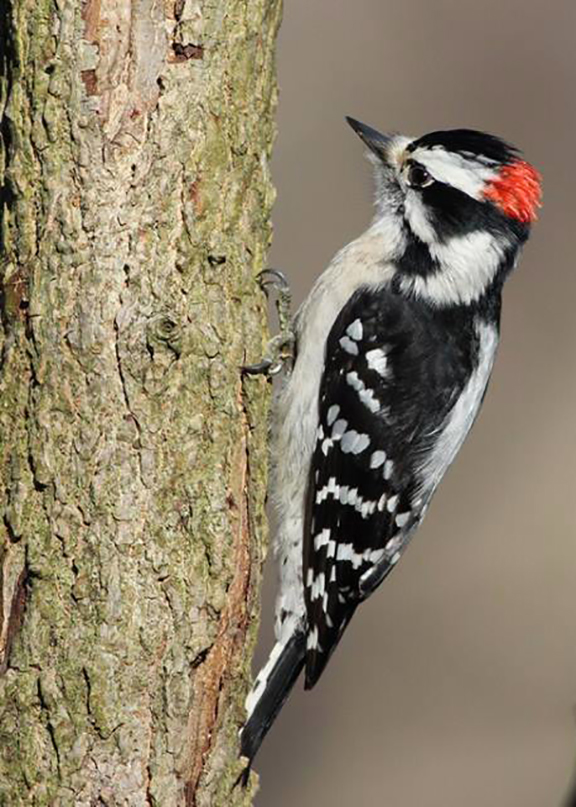
Photo: ©Christina Baal
The downy woodpecker (Dryobates pubescens) is the smallest species of woodpecker in North America. They nest in the forest in Marshlands Conservancy in tree cavities they excavated, or in natural hollows in a dead tree or tree limb
Hours of and Directions to Marshlands Conservancy in Rye, N.Y.
Marshlands Conservancy is open year-round. The three miles of hiking trails are open daily from dawn to dusk. There are one-and-a-half miles of shoreline. The visitor center is open from Tuesday through Sunday, from 9 a.m. to 4 p.m.
Directions
Marshlands Conservancy is located at: 220 Boston Post Road, Rye, NY 10580.
Google Maps
Contacts
Marshlands Conservancy Nature Curator Michael Gambino:
phone (914) 835-4466 or email mxg3@westchestergov.com
Friends of Marshlands Inc:
P.O. Box 237
Rye, NY 10580
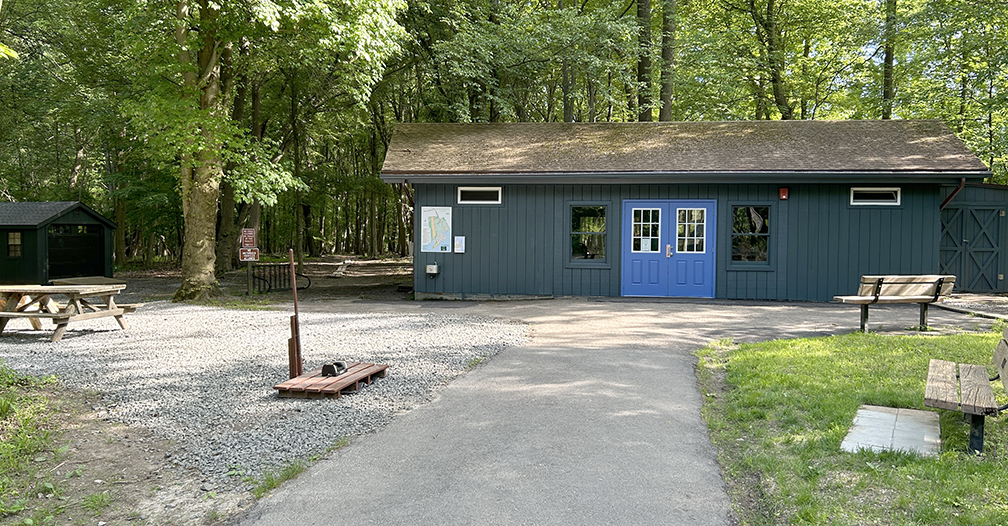
Photo: ©Michael Gambino
The visitor center
Visitor Center
The visitor center is open Wednesday through Sunday, from 9 a.m. to 4 p.m., year-round. Trail maps; flyers on courses, events, and outdoor exhibits; a bird sighting list; and other information is posted on the walls outside the visitor center.
Bird feeders hang outside the large bird viewing window on the south side of the visitor center. There you can see a variety of birds, including wild turkey (Meleagris gallopavo), white-breasted nuthatch (Sitta carolinensis), mourning dove (Zenaida macroura), blue jay (Cyanocitta cristata), northern mockingbird (Mimus polyglottos), and song sparrow (Melospiza melodia). The eastern chipmunk (Tamias striatus) and eastern gray squirrel (Sciurus carolinensis) also come to eat the seeds.
 Photo: ©Rory Mulligan
Photo: ©Rory MulliganWild turkeys (meleagris gallopavo) in the forest, behind the visitor center
 Photo: Wikipedia
Photo: WikipediaChipmunks (Tamias striatus) live in the old stone wall close to the bird feeder
Nature Curator, Michael Gambino Curates a Variety of Exhibitions, Including Biannual Art, and Photography Exhibitions, and Hosts Poetry Readings, all Organized with the Friends of Marshlands.
The visitor center houses changing exhibitions on a variety of topics, including local plants, animals, and birds; local geology; and the history of the area.
Twice a year the center hosts art and photography exhibitions and poetry readings all on themes connected to the conservancy. Exhibition opening days are social events, where exhibitors meet and mingle with the visitors. Snacks and drinks are served. We look forward to welcoming you to these events!
Trails
Trails are open year-round from dawn until dusk. Three miles of trails crisscross the conservancy. To read more about the different ecosystems. (See Habitats).
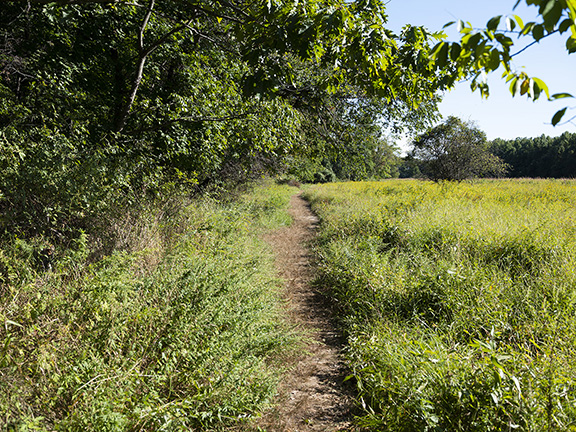 Photo: ©Rory Mulligan
Photo: ©Rory MulliganPath along the edge of the meadow
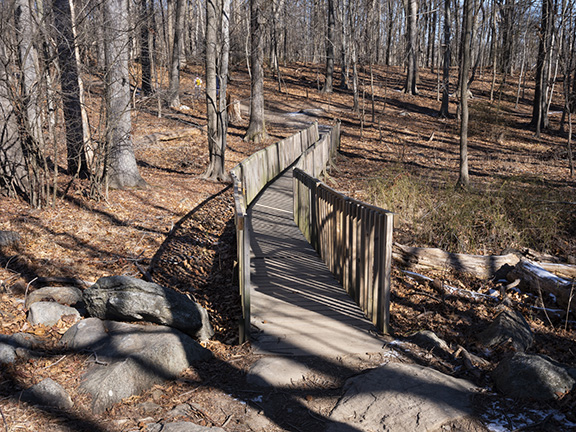 Photo: ©Rory Mulligan
Photo: ©Rory MulliganA boardwalk built over a wetland trail in the forest
The trails are mostly well-worn natural paths. Wooden boardwalks cross above marshy areas and streams. The paths are easy to follow and walkability ranges from very easy to moderately difficult. The steepest path leads from the field down to the salt marsh.
Trail Map

